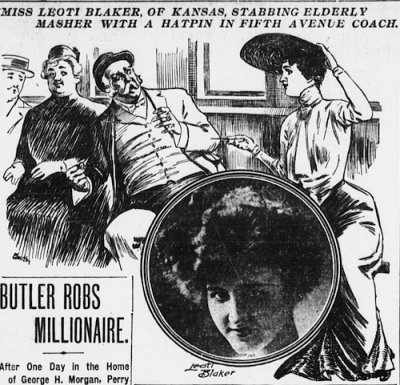This 2017
Atlas Obscura article provides an overview of the hatpin-as-masher-defense phenomenon.
Before Mace, a Hatpin Was an Unescorted Lady’s Best Defense
THERE WERE ONCE, AMONG THE rogues’ gallery of men who harass women in public, disreputable fellows known as mashers. The masher took a lady’s arm, the masher took liberties, the masher might, with the slightest provocation, take advantage. He approached a woman he did not know, to ask her to a dance or to ask if he hadn’t met her somewhere before. The masher, above all, the
Scranton Truth explained in 1914, was “just a plain cad … a coward, too, for he knows that an unescorted girl can only express her resentment by ignoring him.” But women had another tool in their arsenal to swiftly prick and deflate the masher’s inflated ego: the hatpin. ...
By 1901, fashionable hats had grown into towering monstrosities of taffeta, silk, ribbons, flowers real and fake, ostrich feathers, and even artificial fruit. Affixing these edifices to those hairstyles required stout hardware, sometimes of six, eight, even 10 inches in length. All the ingredients were there—ridiculous hair, even sillier hat—for a perfect hatpin storm. ...
This period also saw more women were walking alone or in unaccompanied groups, which some men found either morally affronting or desperately alluring. Unchaperoned women began to experience sexual harassment on the street or on public transportation more than ever before. But, for “perhaps the only time in American history,” writes Kerry Segrave, in
The Hatpin Menace: American Women Armed and Fashionable, 1887–1920, “virtually all American women went out and about armed with a deadly (though legal) weapon.” That weapon attached their hats to their hair—and it was so effective that within a decade, proposed legislation to curb these accessories to assault had bubbled up across the United States. ...
For all their utility, the hatpin was most of all an unexpected consequence of the extraordinary hat. Without the headwear, the pins were just weapons. Fashionistas of the time favored hats with real plumage, which led to the slaughter of thousands, even millions, of birds every year. Lobbyists called for an end to this needless killing, lest the birds go extinct. In 1918, the Migratory Bird Treaty Act made it illegal to kill, sell, or transport certain birds and feathers. It was a hatpin through the heart for these millinery miracles. By the 1920s, women were bobbing their hair short and wearing cloches, turbans, tam o’shanters. Hatpins were largely retired—and mashers breathed a skeevy sigh of relief.
FULL STORY:
https://www.atlasobscura.com/articles/hatpins-mashers-self-defense-history-women-hats-fashion


